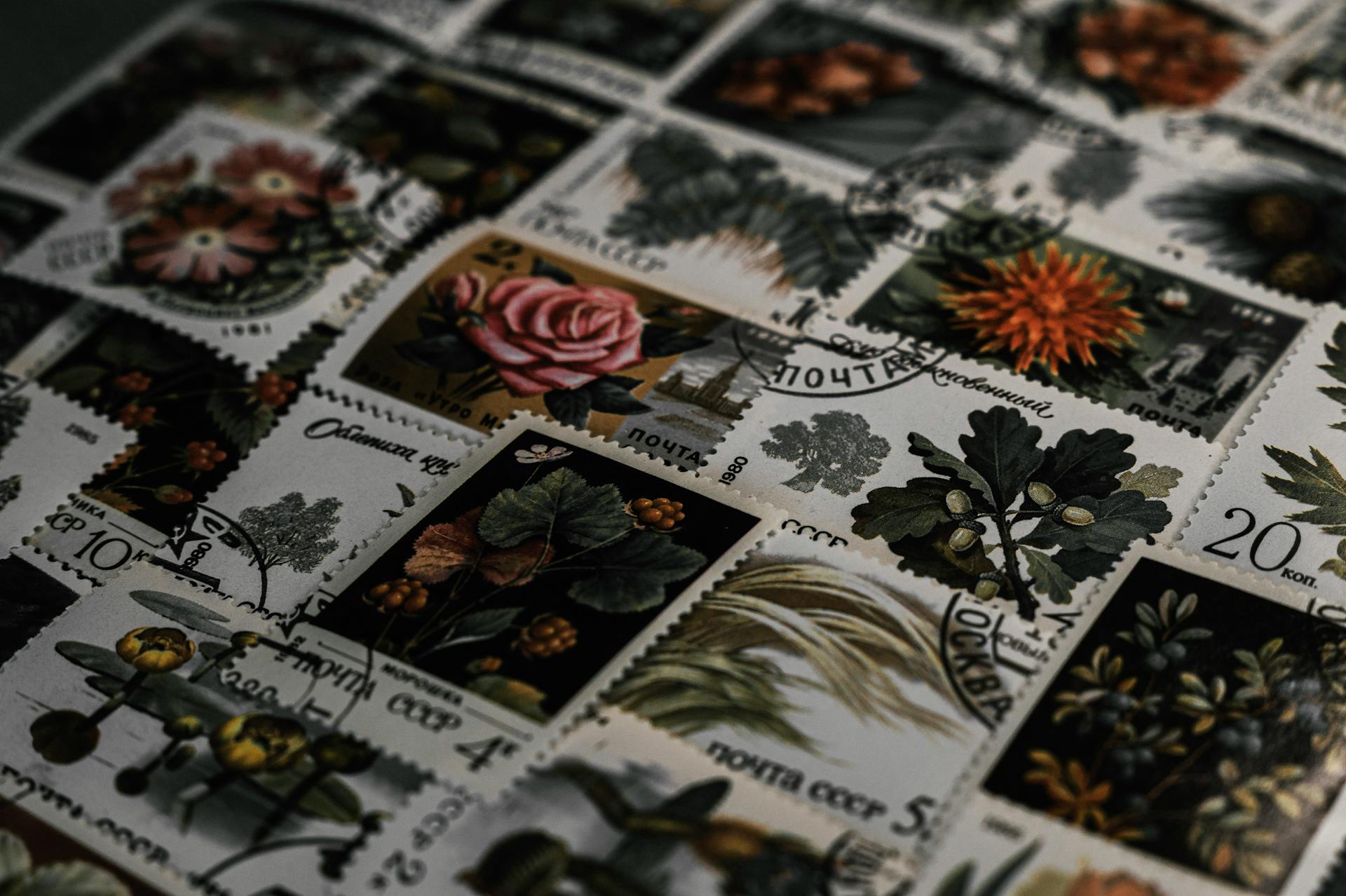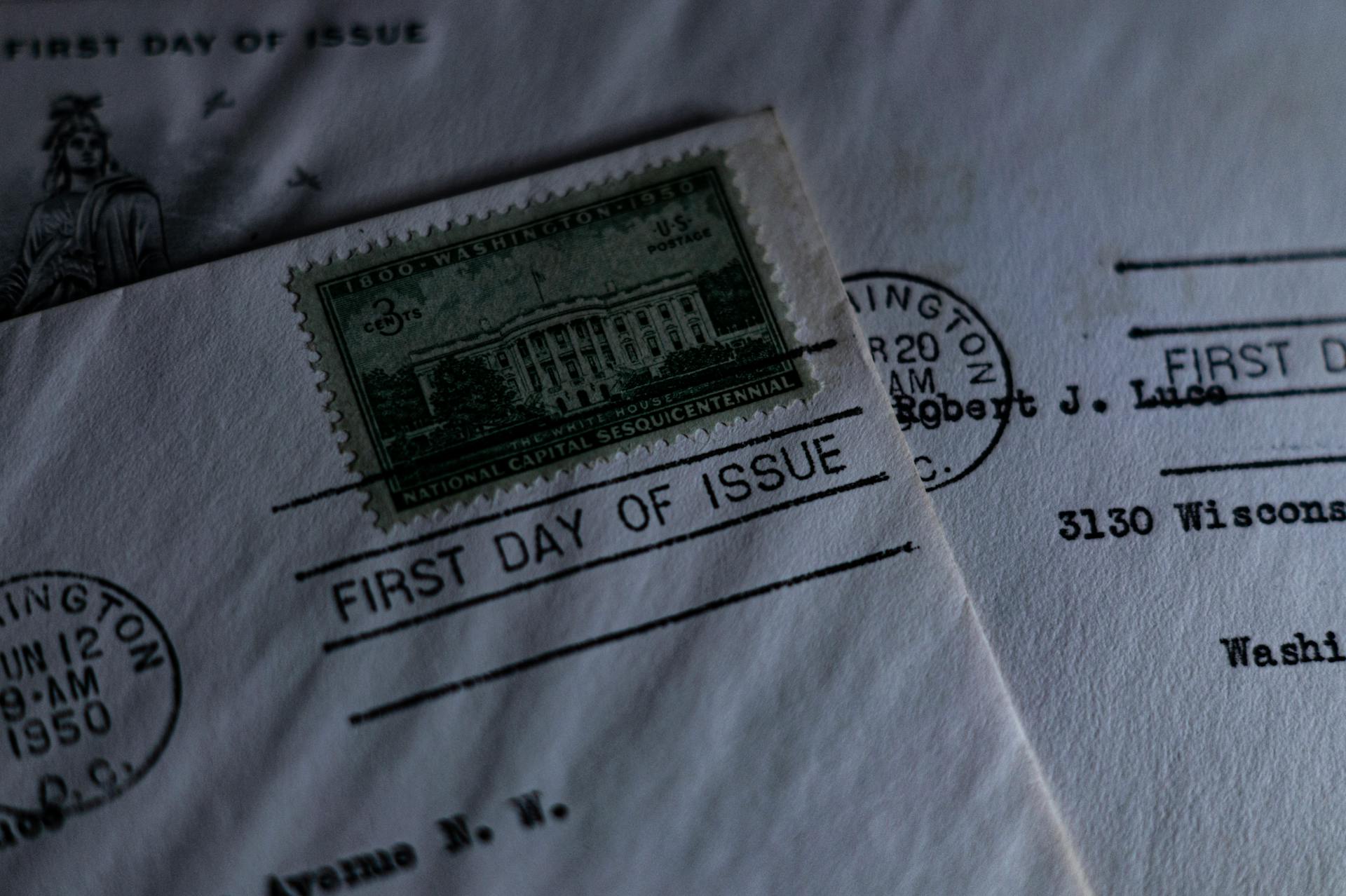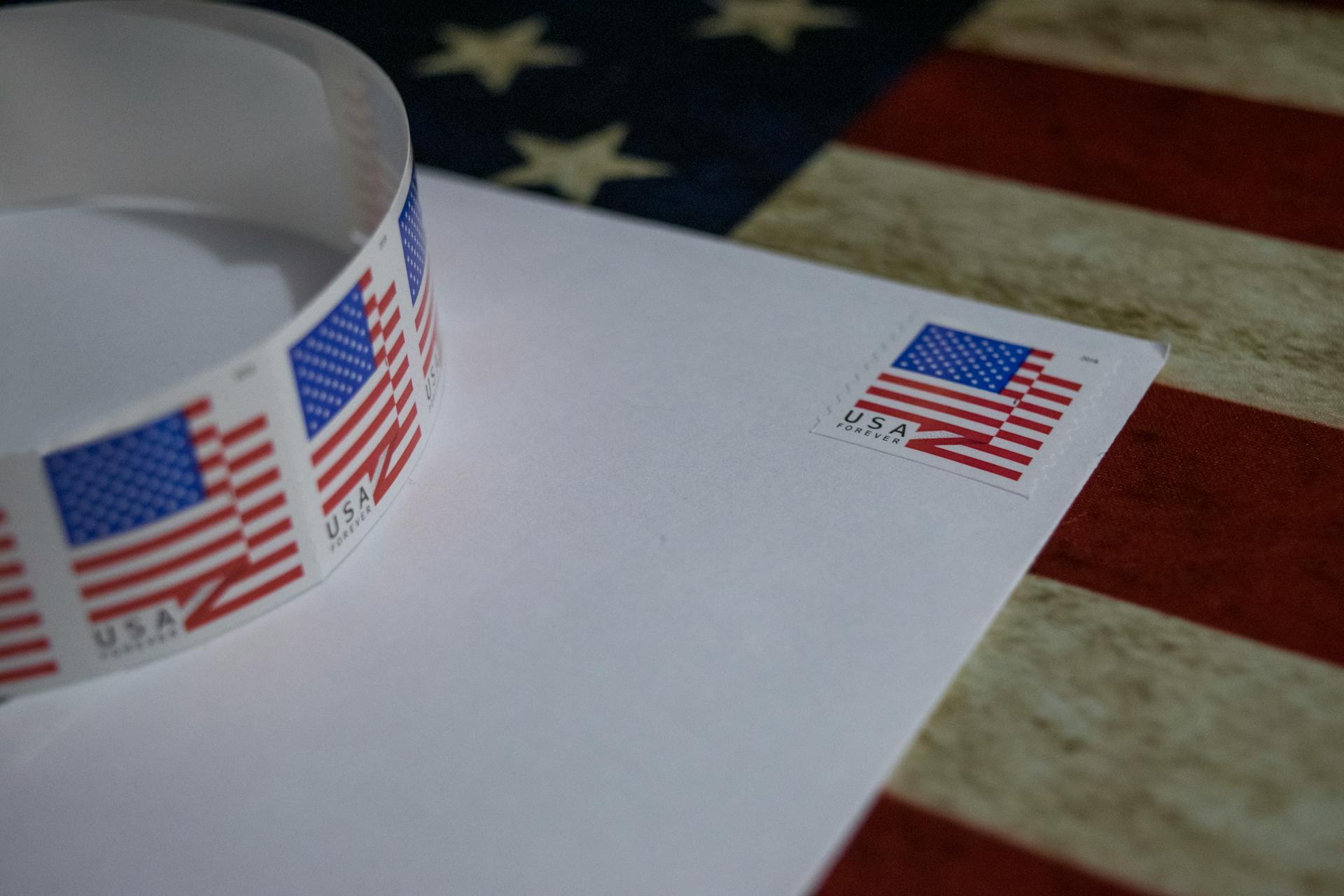
The first US postage stamp was a game-changer in mail history, marking the beginning of a new era in communication.
The Benjamin Franklin stamp, issued in 1847, was the first postage stamp ever produced in the United States. It featured a portrait of Benjamin Franklin, one of America's founding fathers.
This stamp was a significant milestone because it standardized the cost of mailing a letter, making it easier and more affordable for people to send mail. The cost was set at five cents for a half-ounce letter.
The introduction of the first US postage stamp revolutionized the way people communicated with each other, paving the way for the modern postal system we use today.
The First Stamps
The first U.S. postage stamps were issued in 1847, featuring Benjamin Franklin and George Washington. These stamps were a significant step towards making our postal service more efficient and easier to use.
The stamps were designed to be used for pre-payment of mail, and they were available in major post offices on July 1, 1847. However, due to production delays, only the New York City post office received the stamps on that date.
The stamps were produced until 1851, and they came in two denominations: 5¢ and 10¢. The 5¢ stamp featured Benjamin Franklin, while the 10¢ stamp featured George Washington. Letters mailed a distance of 300 miles or less were 5¢ per half ounce, while those mailed over 300 miles were 10¢ per half ounce.
The use of postage stamps greatly improved communications across the country, and it wasn't until 1856 that the use of postage stamps became mandatory.
2-Cent Washington
The 2-cent Washington stamp is a fascinating topic in the world of philately. It's the primary payment for first-class domestic mail and the most commonly available stamp during the 1890s.
Design variations and color varieties abound in these printings, making them a treasure trove for students of postal history. The three distinct triangles seen on these stamps are a result of excessive wear on the plates, which led to repairing and re-cutting the plates over time.
The Type I triangle appears in the 1894 unwatermarked printings on pink, carmine lake, and shades of carmine. The Type II and Type III triangles occur on shades of carmine only.
All three Types of triangles occur in shades of carmine on the watermarked papers used for the 1895-1898 printings. Pairs of stamps showing Type II and Type III triangles are known, demonstrating the re-entry process discussed above.
The 1898 printings are found in many shades of red, carmine, orange, and pink but will always be the Type III triangle with the re-cuttings of the vignette, and they are referred to as Type IV.
Today in History
Today in History, we're taking a look at the first U.S. postage stamps issued on this date in 1847.
The Post Office Department issued its first two U.S. postage stamps, a 5-cent stamp featuring Benjamin Franklin and a 10-cent stamp with George Washington.
They were issued on pregummed, nonperforated sheets, from which clerks used scissors to cut out each stamp.
Benjamin Franklin was the first postmaster of the U.S., a fact that's still relevant today.
The Post Office Department bought out Alexander M. Greig's City Despatch Post, a private New York City carrier, which had issued the first adhesive stamps in the U.S. in 1842.
Private postal services were still used for a short time after 1847, until the national postal system kicked into full gear.
The issuance of a unified, nationally recognized set of postage stamps in 1847 was an important step toward making society function in an efficient, rational manner for the good of all.
The Inspiration
The inspiration for the first U.S. postage stamps came from a famous portrait of Benjamin Franklin. This portrait was created by the French artist Joseph Siffred Duplessis, and it's still widely recognized today.
The portrait was used on banknotes before it was featured on the first U.S. postage stamps. Benjamin Franklin was chosen for the stamp because he was the first postmaster of the United States.
The engraving of the portrait was done by John B Longacre, who based his work on Duplessis' original painting. Longacre's engraving was then used by Asher Brown Durand to create the vignette that appears on the stamp.
The vignette, or the central image on the stamp, is a key part of its design. In this case, it's a portrait of Benjamin Franklin that has become an iconic symbol of the U.S. postal service.
Three-Cent Jackson
The 3-cent Jackson stamp is a fascinating one, and I'm glad it was included in the issue.
It was likely included as a contingency to cover the increase in first-class postage from two cents to three cents.
This stamp can be found in many shades, and a crisp color on white paper is a rare and exciting find.
The 3-cent Jackson stamp doesn't have a color change, so you won't need to worry about identifying a third printing.
4-Cent Lincoln
The 4-Cent Lincoln is a beautiful stamp featuring a portrait of Abraham Lincoln.
It was part of the First Bureau Issue and was used primarily to pay double-weight first-class postage.
The 4-cent Lincoln stamp was produced in various printings, including unwatermarked dull brown and watermarked paper in different tints of brown.
The third printings were issued on watermarked paper in orange brown, lilac brown, and rose brown.
In December 1898, the U.P.U. printings upgraded the color to lake and claret shades.
Only about half of the stamps printed on paper watermarked “USIR” (U.S. Internal Revenue) could ever be identified because of the “I” or “R” watermark.
The unwatermarked printing can also be found in the vertical format, imperforate horizontally.
1847 Imperf Set
The 1847 Imperf Set was a groundbreaking moment in postal history, marking the first time the US Post Office Department issued its own government-issued stamps.
These stamps were printed on pregummed, nonperforated sheets, which made them a bit tricky to handle - clerks had to use scissors to cut out each stamp.
The 5-cent stamp featured Benjamin Franklin, the first postmaster of the US, and the 10-cent stamp featured George Washington, the first US president.
The 5-cent issue almost pictured Andrew Jackson, but was changed to Franklin to promote unity during a time of division in the country.
The stamps were made available in major post offices on July 1, 1847, but due to production delays, only one office, New York City, received them on that date.
They were produced until 1851, and marked an important step towards making society function more efficiently.
Letters mailed a distance of 300 miles or less were 5¢ per half ounce, while those mailed over 300 miles were 10¢ per half ounce.
The sender could pay postage at the time of mailing, or the addressee could pay upon receipt.
With pre-printed stamps, accurate records could be kept of how many were issued and sold, making inspections and record-keeping much easier.
It wasn't until 1856 that the use of postage stamps became mandatory.
About U.S. Stamps
The first US postage stamp was a game-changer for our postal service, and it's interesting to learn about the different periods of US stamps. The first stamps were actually issued by postmasters, who provided their own distinct stamps for pre-payment of mail.
The first government-issued stamps were introduced in 1847, featuring Benjamin Franklin and George Washington. These stamps were available in major post offices, but due to delays in production, only one office, New York City, received them on the initial release date.
The rates for mailing letters were determined by weight and distance, with letters mailed over 300 miles costing 10¢ per half ounce. Postage could be paid by the sender or the addressee upon receipt.
Here are the main periods of US stamps:
- Postmasters' Provisionals (1845-1847)
- Classic Period (1847-1893)
- Bureau Period (1894-1939)
- Modern Period (1940-Present)
- Air Post Issues
- Special Use Stamps
Frequently Asked Questions
Who was the first person on the US postage stamp?
The first person featured on a US postage stamp was Benjamin Franklin. He was followed by George Washington, marking the beginning of a long tradition of honoring diverse individuals on American stamps.
How much is the first stamp ever made worth?
The first Penny Black stamp, made in 1840, is worth over $8 million. Its value has increased significantly from its original cost of a single penny.
Sources
- https://info.mysticstamp.com/this-day-in-history-july-1-1847_tdih/
- https://www.peoplesworld.org/article/today-in-history-first-u-s-postage-stamps-issued-and-what-that-means/
- https://www.theswedishtiger.com/ID0.html
- https://postalmuseum.si.edu/exhibition/about-us-stamps-bureau-period-1894-1939-definitive-issues/first-bureau-issues-1894-1898
- https://www.mysticstamp.com/1-2-complete-set-of-2-1847-imperforate-stamps/
Featured Images: pexels.com


